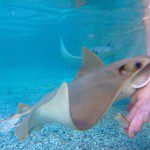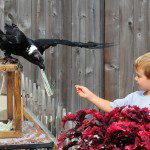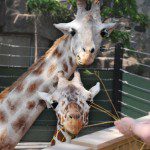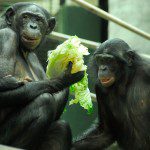I love the Milwaukee County Zoo so much. Every single year we go, there is always something different, new and exciting!
Even though I have been there so many times, I still need to look up hours, admission prices and more each time I go. Here are some fun facts about the Milwaukee County Zoo as well as hours and admission to make your visit an easy one. Make sure you check out all the Family Free Days listed as well!
10001 W Bluemound Rd Milwaukee, WI 53226
Phone: 414.771.3040
| Official Opening: | • 1892 – Washington Park Location • Late 1950s – Bluemound Road Location |
| Location: | 10001 West Bluemound Road Milwaukee, Wisconsin 53226 |
| Hours: | January 2 through February / November & December 2014 Monday – Friday 9:30 a.m. – 2:30 p.m. Saturday – Sunday 9:30 a.m. – 4:30 p.m.March 1 – May 23, 2014 Daily 9 a.m. – 4:30 p.m.May 24 – September 1, 2014 Daily 9 a.m. – 5 p.m.September 2 – October 31, 2014 Daily 9 a.m. – 4:30 p.m.Open 365 days per year |
| Admission: | January 2 – March 31 and November – December 2014 Adult: $11.75, Child (3 to 12): $8.75, Child (2 and under): FREE, Senior Citizen (60+): $10.25, Bus Parking: $16, Parking: $12April 1 – October 31, 2014 Adult: $14.25, Child (3 to 12): $11.25, Child (2 and under): FREE, Senior Citizen (60+): $13.25, Bus Parking: $16, Parking: $12Milwaukee County residents with I.D. receive $1.75 off regular Zoo admission every day. Every Wednesday, Milwaukee County residents with I.D. are admitted at a reduced rate of $8 for adults and $5.50 for juniors. 2014 Family Free Days at the Zoo January 4, February 1, March 1, April 5, |
| Operating Status: | • County owned and operated • Supported by Zoological Society of Milwaukee County |
| Attendance: | 2013 – 1,232,899 |
| Economic Impact: | $112 million |
| Personnel: | 115 full-time, 500 seasonal employees |
| Specimens: | 3,107 specimens representing 424 different species |
| Administration: | Divisions include: Animal Management and Health, Administration and Finance, Public Affairs and Services, and Operations. |
| Handicapped Accessibility: | All animal buildings and exhibits are accessible to the handicapped. The Zoo adheres to the ADA. |
| Education: | The Zoological Society’s Education Department provides guided and self-guided tours to school and youth groups, day camps for individual youth, family programs and adult workshops. |
| Acreage: | 200 acres |
| Architecture: | The original Zoo was designed by the following: the Milwaukee County Planning Department (now called Architectural Engineering), the Milwaukee County Landscape Architect, the professional Zoo staff and private architecture firms. |
| Mission Statement: | To inspire public understanding, support and participation in global conservation of animal species and their natural environment by creating a unifying bond between our visitors and the living earth. |
| History / Present Site: | The Milwaukee County Zoo began in the 1890s as a miniature mammal and bird display in a barn at what is now Washington Park. By 1902, the Zoo had 23 acres of land and 800 animals. In 1937, when all parks went under the jurisdiction of the Milwaukee County Park Commission, the Zoo had grown to 38 acres. In the 1950s, the Zoo was moved to its present 200-acre location bordered by Highway 45, Bluemound Road, Highway 100 and Interstate 94. |
| Funding: | The Zoo receives funding through a cooperative effort of Milwaukee County and the Zoological Society of Milwaukee County. |
| Volunteers: | Zoo Pride is the volunteer auxiliary of the Zoological Society. Its members serve as goodwill ambassadors at the Zoo and in the community. Started in 1975, Zoo Pride shares a deep commitment to the Milwaukee County Zoo and its residents. |
| Zoological Society of Milwaukee County: | It began in the 1890s, as an informal group of clubs and associations. The Society started by purchasing animals and securing Zoo animal donations.Today, the Society helps Milwaukee promote one of its finest assets by funding animal acquisitions, fundraising campaigns for building renovations and improvements, new exhibits and financial support for research and educational programs.Membership in the Zoological Society is open to everyone. Individual, family and corporate memberships are available year-round. Members receive special daily admission benefits to the Zoo, a 10% discount at all gift shops, advanced notice of special events, invitations to members-only events and other special programs. |
| Zoological Society’s Animal Sponsorship: | This program began in July 1982, as a fundraiser. Donations from the annual “sponsorships” are used for exhibit improvement and enhancement for all of the animals at the Zoo. |
| Restaurants: | The Flamingo Lake Café, the Zoo’s restaurant, and Gift Shop are open year-round. Other concession and rest areas are open during the spring/summer months. Lakeview Place, situated in the heart of the park, is scenically located across from Lake Evinrude. |
| Special Events: | The Zoo sponsors unique activities and family-oriented events throughout the year. |
| Group Sales: | Large formal seating rooms, wooded picnic areas and various animal buildings are available for group rentals. The Zoo offers advanced, discounted tickets in groups of 15 or more. Arrange your next “get together” at the Zoo. Convenient, inside-the-park picnic areas also are open for bookings. The U.S. Bank Gathering Place now offers groups a spacious, light-filled atrium, located at the Zoo’s entrance, and the renovated Zoofari Conference Center offers an updated, contemporary atmosphere suitable for larger functions. |
| ANIMAL BUILDINGS | |
| Small Mammals: | This unique building features both day and night animals. With a flip of a switch, day can turn into night, allowing red fluorescent lights to illuminate nocturnal animal exhibits – giving the animals the impression of night. In 2012, the Zoo added a unique animal to this building, a potto, which, in the wild, is found in the canopies of the African rain forests. This is a new species in the Zoo’s animal collection. |
| Florence Mila Borchert Big Cat Country: | The renovated Florence Mila Borchert Big Cat Country opened in 2005. This $7.2 million project provides larger and more natural looking exhibit spaces for these magnificent felines and enhances their quality of life. The exhibits showcase new residents such as jaguars and African lions. In 2011, the Zoo welcomed a litter of African lion cubs, born to mother, Sanura. A species not born here since 1974, the cubs were a popular attraction for our visitors. In the fall of 2012, we welcomed two male jaguars, born to mother, Stella, and father, Pat. This marked the first jaguar cubs born here since 1975. The cubs are highly valuable, as father Pat is a wild-born animal, and brings new genes into the captive population. |
| Herb and Nada Mahler Family Aviary: | Hundreds of colorful birds, towering palms and lush foliage transform this building into a vibrant tropical paradise. Birds from all over the world move freely in naturalistic surroundings. Featured in the Island of Guam Exhibit is one of the world’s rarest birds, the Guam Rail. |
| Stearns Family Apes Of Africa/Primates of The World: | Apes of Africa is an exhibit of Western lowland gorillas and bonobos. Designed to closely represent the West African rain forest, it provides gorillas and bonobos with surroundings similar to their natural environment. In 2011, the Zoo opened a new outdoor public exhibit area for our group of bonobos. These highly endangered apes now enjoy 500 feet of elevated mesh passageways in the Zoo’s forest to simulate their native habitat of the Democratic Republic of Congo in Africa. |
| Primate Complex: | The primate building, fondly called the Monkey House by many, was the Zoo’s first building. In the mid-90s, the building reopened to the public after extensive renovation as Primates of the World. It houses many of the most popular residents at the Zoo, including orangutans, siamangs and spider monkeys.The Primate Complex was a $10.7 million project equally funded by the Milwaukee County Zoo and the Zoological Society of Milwaukee County. |
| Aquatic & Reptile Center (ARC): | The Aquatic & Reptile Center (ARC) displays a fascinating underwater world including a 28,000-gallon Pacific Coast Aquarium housing a variety of sharks and fish.Don’t miss the 30 species of Wisconsin fish swimming in our center exhibit, Lake Wisconsin. |
| Temple Monkeys of Tikal: | Several years ago, the Zoo’s spider monkeys moved into a new home in the form of an outdoor extension to the Primates of the World Building. Inspired by the ruins of a city once the brilliance of the ancient Mayan world, this exhibit doubled its space for these animals, providing a true-to-life rain forest environment. |
| Macaque Island: | This is the official residence for a charming group of Japanese macaques (also known as snow monkeys). In 2002, the Zoo presented a redesigned island, complete with enrichment items, waterfalls, shrubs and vines. |
| FIVE CONTINENTAL GROUPINGS | |
| North America: | A stroll down the hill and around the bend from the Small Mammals Building brings visitors to Lake Evinrude. Sloping upward from its grassy perimeter are rocky ledges, cliffs and woods where representatives of many of North America’s largest animals roam. See caribou, grizzly bears, elk and black bears. Across the path are moose, mule deer and Dall sheep, and a Zoo favorite – polar bear, Snow Lilly. |
| South America: | One of the Zoo’s most diverse exhibits; alpacas delight visitors, while Brazilian tapirs cool themselves in a waterhole and rheas look on. |
| Africa: | Ostriches, African lions, hyenas, zebras, black rhinos, giraffes and hippopotamus are among the African wildlife featured.The Zoo simulates nature by seeming to exhibit predator and prey in the same enclosure. However, the prey is protected from its stalkers by invisible dry moats weaved between the foreground and background exhibit areas.In the African Waterhole, antelope, Chapman’s zebra, ostrich and stork live in close proximity to the African lions. Also, the African Savanna displays the cheetah overlooking the Thompson’s gazelles, impalas and crowned cranes.In 2006, the Zoo unveiled a renovated Giraffe Exhibit – MillerCoors Giraffe Experience. The exhibit features expanded indoor and outdoor spaces for the animals, and the rare opportunity for visitors to get face to face with our reticulated giraffes. The public also can feed these animals for a fee. In 2013, we welcomed two additional female giraffe into the group – Marlee and Ziggy. |
| Australia: | On the far side of the Zoo are the animals from “down under.” Visitors see kangaroos, emus, kookaburra and tree kangaroos. |
| Asia: | Living in natural settings, visitors can see Amur tigers, Bactrian camels and red pandas. |
| Idabel Wilmot Borchert Flamingo Exhibit and Overlook: |
In the summer of 2008, the Zoo welcomed a flock of Caribbean flamingos to their new home across from the Maher Family Aviary. Here visitors can greet these beautiful birds up close, as they roam in their lush yard that includes a pond rimmed with benches for easy viewing. |
| Northwestern Mutual Family Farm: | Formerly known as the Children’s Zoo, this renovated area lets visitors see what life is like on an actual farm. Guests are able to meet native wildlife and farm animals, as educational presentations are offered daily in the new Stackner Animal Encounter Building. A “play and climb” area, walk-through butterfly garden and renovated Birds of Prey Theater complete the experience.In 2011, from Memorial Day through Labor Day, interactive theatrical performances began daily in the new Kohl’s Wild Theater. |
| The Dairy Complex: | In the Family Farm’s octagonal barn, you can see six varieties of dairy cattle in the cow barn; discover more about the dairy industry through hands-on experiences in the learning center; and sample and/or purchase various dairy products in the dairy store. The new Munchkin Dairy Farm, funded by Northwestern Mutual Foundation, opened in 2011. |
| SEASONAL ACTIVITIES (Available during warm-weather months) | |
| Birds of Prey Show: | These dynamic presentations now take place in our newly renovated raptory theater. |
| Animals-in-Action: | Take a closer look at some of the Zoo’s animals at these special presentations. Learn animal facts during a short presentation by zookeepers and Zoo Pride volunteers. |
| North Shore Bank Safari Train: | Relax and enjoy the miniature train ride through the beautiful Zoo grounds. Runs daily, weather permitting. |
| Zoomobile: | An interesting guided motor vehicle tour operates daily, weather permitting. Tours generally depart every 15 to 20 minutes. The 30-minute ride gives an excellent overview of the Zoo. |
| Penzeys Spices Carousel: | Experience a ride on an authentic, turn-of-the-century classic carousel. Detailed, handcrafted figures including giraffes, zebras, ostriches and tigers are patterned from originals dating back to the early 1900s.The carousel is located across from Zoo Terrace near the train station (handicapped accessible). |
| SkyTrail® Explorer Ropes Course and Zip Line Sponsored by Tri City National Bank: | This new visitor attraction opened in 2011, featuring a 500-foot zip line and two ropes courses, one for children and one for adults. These adventure courses are open in the spring, summer and fall. |
| Sky Safari Sponsored by PNC: | Visitors can go above it all and see the Zoo from a new perspective! Guests board the Sky Safari across from the South American yard and travel round trip above the camels, tigers, Asiatic black bears, and rhinos. |
| Oceans of Fun Seal/Sea Lion Show Sponsored by Anderson Seal, LLC: | The sea lions delight audiences with their entertaining and educational show, four times daily, seven days a week during the spring, summer and fall. This 20-minute show features California sea lions and harbor seals. |
| Animal Rides: | Kids can take a camel or pony ride along a guided path. Check your Zoo gate brochure map for the location. Souvenir photos are available for an additional charge. |
| SPECIAL EXHIBITS & POINTS OF INTEREST | |
| Sting Ray & Shark Bay Sponsored by Sendik’s Food Markets: | Beginning May 24, and running through September 1, the Zoo will welcome back a popular exhibit, “Sting Ray & Shark Bay.”Splash into this tropical exhibit, and get up close with sting rays and sharks! The species of sting rays are safe to touch, as the spines on their tails have been trimmed, much like trimming human fingernails. The varieties featured include cownose rays and southern rays.The sharks displayed also are harmless to touch. Notice the bonnethead shark as it swims through the shallow water with its characteristic semicircular head. Their hammer-shaped head allows them to “scan” significantly larger areas of the ocean’s bottom when hunting.Other shark species featured include bamboo sharks, commonly known as longtail carpet sharks. These species have unusually long tails, which exceed the length of the rest of their bodies.The exhibit is $2 per person after regular Zoo admission.
Source: Milwauke County Zoo (website) |







Leave a Reply